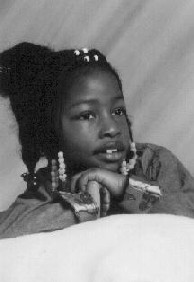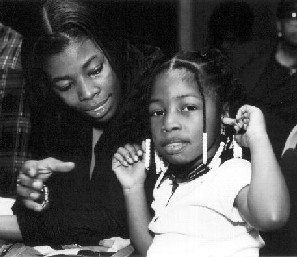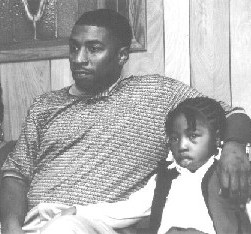Five-Year-Old Girl with Sickle Cell Disease
by Laura Douglas
December 2000/January 2001
 Photo: Portrait of Jonee |
As a woman of European American descent, I’d occasionally heard of sickle cell disease, but knew nothing at all about it or what people with it go through–except that it is a malady mainly affecting persons of African ancestry and that it has something to do with anemia. Therefore, I was tremendously affected to learn about one family’s heartrending personal experience with sickle cell disease from the Bradleys, whom I was privileged to meet at Rev. Al Sharpton’s National Action Network in Harlem. The Bradleys daughter Jonee, who is only five years old, has sickle cell disease and needs blood donations.
I could see from just looking at them how much the parents, Anthony and Cherise, and Jonee’s ten year old sister, Jamesha, love Jonee and are doing their best for her. I had the opportunity to speak with Mrs. Bradley, and I tell about it now because I’m sure everyone who can will want to assist. It could come down to a matter of life and death for Jonee.
Mrs. Bradley explained their urgent need to make contact with persons of African ancestry who have O-Positive blood without certain antigens which have built up in Jonee’s blood from previous transfusions. They’re looking for persons with the right blood who are willing to take part in the buddy system, meaning that if something happens and Jonee needs blood, they will give it.
 Photo: Jonee and her mother Credit: James L. Johnson |
Jonee is an outgoing, likable little girl who likes music and dancing. She already knows her letters and loves writing words and numbers. She also loves being read to, and when they go to the library every week to pick out five books, she usually wants to hear all of them in one night. She’s in kindergarten at Summit Park School in the East Ramapo School District in Rockland County where the family moved three years ago from Queens, New York.
Jonee’s father, Anthony Bradley, is an electrician with Local 3. Cherise Bradley doesn’t work because Jonee has already been in the hospital twenty-five times, so it’s impossible to keep a job and also take care of her. “I’m not going off and leaving my child alone in the hospital,” she said, “I stay there nine days, ten days, whatever–that is my new address while she’s there.” She said that Anthony and Jamesha often travel back and forth to the Long Island Hospital where Jonee is treated, and they were grateful that the Ronald McDonald House put them up last summer so they didn’t have to travel so much. Mrs. Bradley said of the effect Jonee’s illness has had on their marriage of twelve years: “My husband and I were already close, but this has brought us even closer.”
Mrs. Bradley told me she was aware that she had sickle cell trait but knew nothing about it and didn’t know anyone with the disease. She has learned that sickle cell disease is an inherited disorder of the red blood cells which carry oxygen to all parts of the body by using a protein called hemoglobin. The hemoglobin in normal red blood cells are doughnut shaped, which makes them very flexible so they move easily through the small blood vessels. In sickle cell disease, the red blood cells are sickle shaped and pass with difficulty through the tiny blood vessels. They can become stuck, clogging up the capillaries so the necessary oxygen can’t get to all the parts of the body as it should. This blockage is very painful and also damaging to the tissue, and it can occur anywhere in the body.
 Photo: Jonee and her father Credit: James L. Johnson |
Mrs. Bradley said they found out that Jonee had sickle cell disease from the screening hospitals do on all babies after they’re born, but when they told her she thought, “Well I have the trait; maybe it’s going to be nothing.” However, when Jonee turned two, she started getting sick, and she’s been in and out of the hospital ever since. That was when Jonee, like most children with sickle cell disease, had her first “painful crisis” as they are called, where the sickle cells caused the blood to get stopped up at a joint, and oxygen can’t get to the limbs. She said, “Jonee could not move her legs, and then she literally could not stand up. She was pale yellow. I didn’t understand what was going on. That was when she first had to go in the hospital and we started learning about it.”
Mrs. Bradley also explained that a child with sickle cell disease has to be hospitalized every time she gets a fever because it can be a sign of something very serious. Dehydration resulting from a fever causes the cells to sickle even more. All normal babies get ear infections, go through teething and have all kinds of things that give them a fever, but since Jonee needed hydration every time she got a fever, they were constantly going to the hospital for the next two years.
A year ago, when Jonee was four, she had her first stroke. This, too, was a result of the disease because the sickle cells had gotten trapped in her head and stopped the proper oxygen supply to the brain.
I had such sympathy as Mrs. Bradley told me about it. She said that she and Jonee were in the living room and Jonee was playing on the computer. “Jonee left the room for a short while and when she came back she was just laughing and laughing. She then went from a laugh to a cry just like that and I freaked. I was saying ‘What’s going on, what’s the matter?'”
At first she thought maybe Jonee’s hand was numb from using the mouse on the computer for so long, and that maybe she was crying because it felt like needles in her hand. Later, Mrs. Bradley saw Jonee was limping so she called the pediatrician who told her to look at Jonee’s face and see if it looked twisted. She saw that Jonee’s face was a little twisted and the pediatrician said she’d likely had a stroke and needed to be brought to the hospital immediately. Mrs. Bradley said, “We went to the hospital and yes, she’d had a stroke. She couldn’t move her whole right side. When she came out she had to go to rehabilitation for six weeks to learn how to use that whole side again.”
Mrs. Bradley told of how in October Jonee and Jamesha were playing in the driveway and Jonee went to come in the house and fell. When Jamesha carried her up the stairs her leg was twitching. “So I rushed her to the hospital and they said she’d had another stroke. She had to stay in for nine days and go to rehabilitation again.”
After the first stroke, Mrs. Bradley said, the doctors put Jonee on a blood exchange program where they would take out some of her blood and give her normal blood to try to keep her hemoglobin level up so she had less chance of having another stroke. But when she was on that protocol for about three months, it was discovered that her body was building up antigens against the blood, so the blood was really making her sick. Now they put her on a new medication and it seems to be OK. However, if she gets sick again she will need blood right away, and it will need to be the right blood in order to do her good.
For information about how you or someone you know might assist, please call the Bradleys at (914) 426-2290 or contact them by e-mail at JJAC131@gateway.net. You could help save this child’s life!
Copyright © 2000 Laura Douglas and The Multiracial Activist. All rights reserved.


Date: Mon, 4 Dec 2000 15:51:33 -0800 (PST)
From: Frances Onipede
Subject: Letter to the Editor
Thank you and thanks to Laura Douglas for her guest commentary, “Five Year Old Girl with Sickle Cell Disease.” Also for her call for help with blood donations.
This is a fairly common condition in humid, tropical West Africa where malaria is endemic. Many Americans are of West African descent and may have the gene for sickle cell. Malaria is one of the main causes of infant mortality and those with the sickle cell gene seem to have a certain degree of immunity or resistance to malaria and grow up to the age when they can have children. They do however suffer terribly from the disease. Because it is a hereditary disease, medical and government authorities in West Africa urge people who have the gene on both sides of their families not to marry. Surely this is a job for the genetic engineers to get busy on!
A very good friend, Dr. Charles Adeyinka, died of it in his forties some years ago. He could not get admission to a medical school in the USA because of his condition but was admitted to Queens University, Belfast, Northern Ireland, where he qualified and practiced medicine in Nigeria for fifteen years. People were amazed that he could cope so well but there are many such cases where good medical treatment can help one to live a better life.
There are several organizations in this country and the United Kingdom concerned with this disease. The Sickle Cell Disease Association of America has a Sickle Cell Information Center (web site sicklecelldisease.org.) It is located in Culver City, CA and has branches in Connecticut and San Diego, CA.
The Sickle Cell Foundation of Georgia includes medical schools at Emory University and Morehouse College. In Boston, Harvard University medical school is involved in the Joint Center for Sickle Cell and Thalassemia Disorders. (Thalassemia is a similar inherited condition affecting Mediterranean peoples in malarious areas.)
There is an organization in New York called S.C.A.R.E. of people who call themselves “sickle defiers.” All these organizations have web sites of great interest.
Again many thanks to you and Ms. Douglas for bringing this matter to public attention. Because comparatively few people are affected, not as much attention has been paid to finding better treatments and a cure as should be.